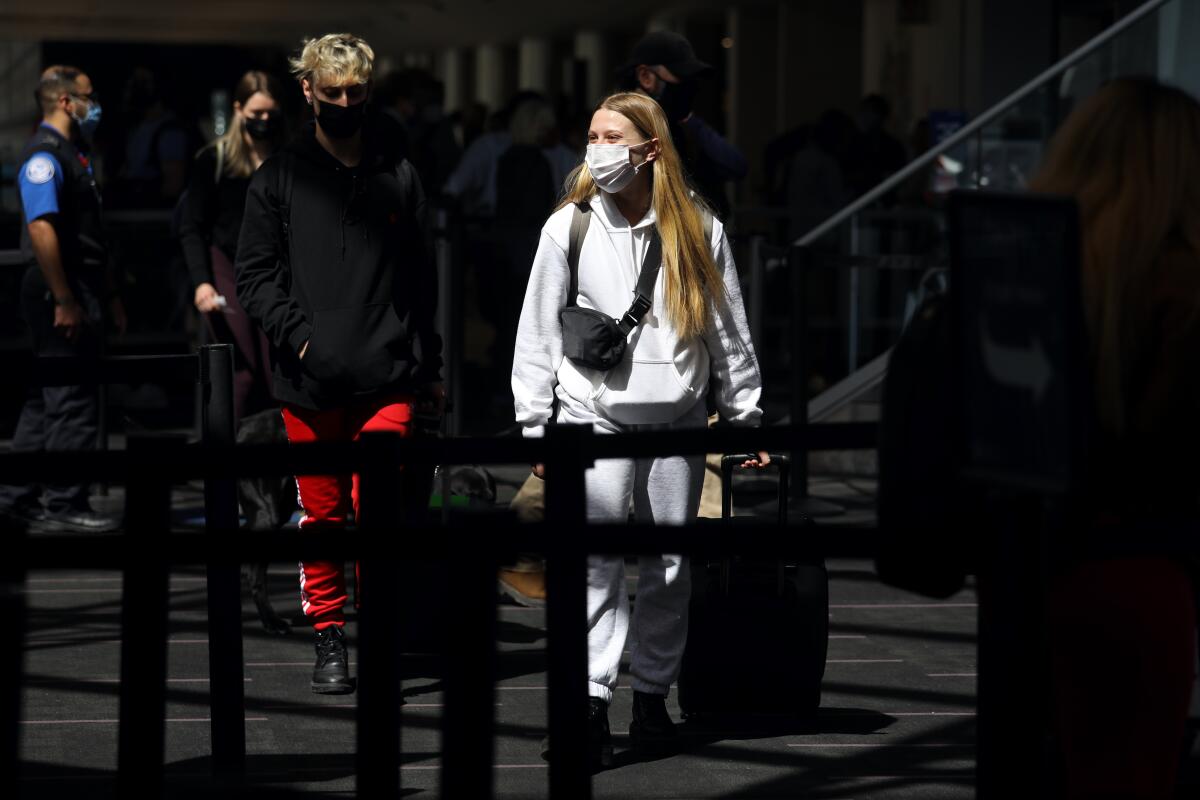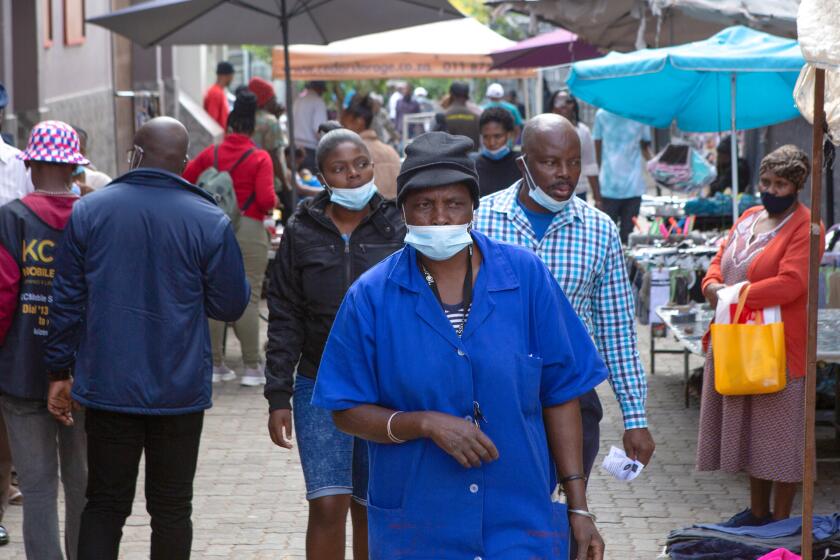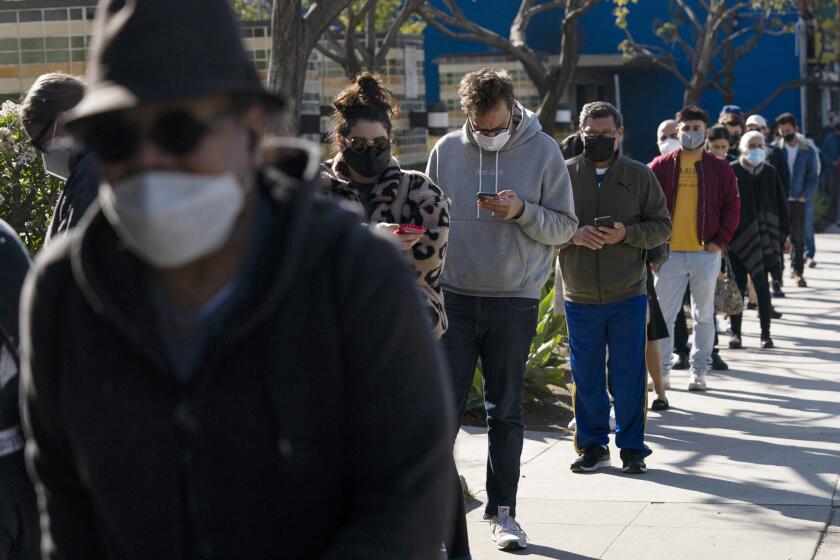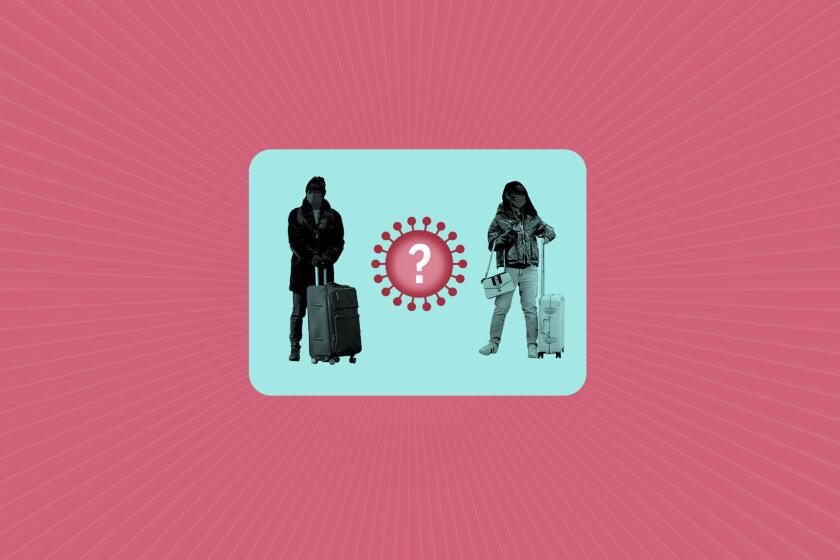New coronavirus variants emerge: BA.4, BA.5 likely reinfecting Omicron survivors

A pair of new Omicron subvariants has emerged, raising the possibility that survivors of earlier Omicron strains can get reinfected.
BA.4 and BA.5 have gained increasing attention in South Africa as weekly coronavirus cases tripled in the last two weeks, according to data from Johns Hopkins University.
“It really came out of the blue over the weekend. We were already settling down with BA.2.12.1, and then BA.4 and BA.5?” said Dr. Peter Chin-Hong, an infectious diseases expert at UC San Francisco. “It just seems like the latest chapter of a never-ending saga.”
The rapid growth of BA.4 and BA.5 in South Africa has implications for a potential future surge in California and the U.S. Until now, scientists had been reassured that people who survived the first Omicron variant over the winter, BA.1, were unlikely to be reinfected by the even more infectious subvariant BA.2, which is now dominant nationwide.
But the surge in cases in South Africa of BA.4 and BA.5 follows an earlier Omicron wave. An estimated 90% of South Africa’s population has immunity to the earlier Omicron variants either due to surviving a natural infection or through vaccination.
“If 90% of people are immune already, and they’re seeing a surge in cases, it means that this particular dynamic duo [BA.4 and BA.5] are causing more reinfections — even in people who already had Omicron,” Chin-Hong said.
Coronavirus cases had been dropping in South Africa, but a new Omicron subvariant that scientists call BA.4 began pushing up infections last week.
Only a small number of cases of BA.4 and BA.5 have been documented in California. In April, one case of BA.5 was documented, and in March, one case of BA.4 was confirmed, according to the California Department of Public Health.
The Omicron subvariant BA.2 remains California’s dominant variant, accounting for 88% of nearly 3,600 analyzed cases in April, while the ascendant BA.2.12.1 and its relative, BA.2.12, accounted for 9% of cases.
BA.2.12.1 is estimated to be 25% more transmissible than BA.2.
Earlier in the pandemic, “it seemed like every few months we heard about a potential new variant of concern,” said Los Angeles County Public Health Director Barbara Ferrer.
But more recently, she said Tuesday, “within weeks of one variant of concern dominating, there are reports from other parts of the country or other parts of the world of other either subtypes or different strains, and this has been especially true with Omicron.”
“When folks ask why public health remains cautious, it is because every time there’s a new variant that is more infectious or potentially more infectious, that means it can spread more easily,” Ferrer said. “You have to be super careful about those that are most vulnerable in our communities. And here in L.A. County, that’s millions of people. It’s not a tiny number.”
Coronavirus cases have risen by nearly 30% in California over the last week. Hospitalizations are up, too.
Will BA.4 and BA.5 lead to another wave in the U.S.?
Some health experts say South Africa’s BA.4/BA.5 wave could repeat in the U.S. — but probably not immediately.
South Africa will begin its winter next month, while summer is coming for the U.S.
But will South Africa’s experience be a prelude to a surge in late summer or autumn in the U.S., as Americans’ immunity from a natural Omicron infection or their last vaccination weakens? Maybe, but “we don’t know,” Chin-Hong said.
Current data do not suggest that BA.4 and BA.5 cause people to get sicker than the earlier Omicron variants. But BA.4 and BA.5 do appear to be more transmissible, Chin-Hong said, and have a better shot at evading existing immunity, given the surge in South Africa.
People who are unvaccinated and haven’t been previously exposed to the coronavirus will have a higher chance of not doing well if infected, Chin-Hong said.
Black and Latino Americans remain far more cautious in their approach to the COVID-19 pandemic than white Americans.
The emergence of BA.4 and BA.5 means “that Omicron is still very much alive and well, and seeking ways in which it can evolve to be even more transmissible,” said Dr. Robert Kim-Farley, epidemiologist and infectious diseases expert with the UCLA Fielding School of Public Health.
Fortunately, the available data so far have not suggested the coronavirus is evolving to give infected people a higher chance of hospitalization or death.
Still, people should be aware of where the pandemic is heading in their own communities, Kim-Farley said. When transmission is high — as it is in L.A. County — it’s time to be more vigilant about wearing masks in indoor crowded places, he said.
And people who are at higher risk for severe illness and death from COVID-19 may want to avoid risky situations entirely, Kim-Farley said.
“We’re in a better place, so we can remain hopeful, but we shouldn’t lose all of our caution,” Ferrer said. “We can remain hopeful because lots of people have a lot of protection. Lots of people are fully boosted. Lots of people are vaccinated. Lots of people were recently infected and have some natural immunity — not sure how durable that is and how long it will last, but it certainly will offer some protection.”
But, she continued, “it is time for people to go get boosted. Go get your first doses of the vaccine if you haven’t yet been vaccinated. And be careful, particularly if you’re around others who are higher risk or you’re at higher risk yourself.”
COVID-19 rules for travelers will vary depending on the destination, but wherever you go, it’s good to be prepared.
Chin-Hong said it’s important for people to know ways to reduce risk. Besides getting up to date on vaccinations and booster shots and wearing a mask in indoor public settings, people also can reduce risk by learning where to get Paxlovid, an anti-COVID pill that can reduce the risk of hospitalization by 90%.
For the immunocompromised, Evusheld is available to prevent COVID-19 among people who haven’t been exposed to the coronavirus and either have a weakened immune system because of a medical condition or cannot get vaccinated for medical reasons.
Kim-Farley said it’s likely there will be increased cases during the summer in California. “However, I’m optimistic that we will not see these translate into high levels of hospitalizations or deaths, just due to the fact that the variants that are emerging appear to be more transmissible but less causing of severe disease and death.”
The more worrisome wild card would be a totally new variant more likely to cause severe illness and death, and against which vaccinations and natural immunity would be less effective.
“The important take-home message for everyone is, still, to be vaccinated, and, if eligible, boosted because these are life-saving vaccines,” Kim-Farley said.
More to Read
Sign up for Essential California
The most important California stories and recommendations in your inbox every morning.
You may occasionally receive promotional content from the Los Angeles Times.
















